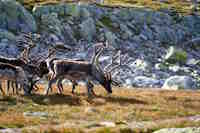Reindeer, also known as caribou in North America, is a species of deer that lives in countries around the Arctic Circle and in the tundra regions there. Reindeer are well adapted to the cold climate and are characterized by their thick fur, wide hooves and elegant horns. In this article, we will review some of the key characteristics of reindeer and how reindeer came to Iceland.
How do reindeer survive the arctic cold
Reindeer have several adaptations that help them survive the extreme cold of Arctic and sub-Arctic environments.
Reindeer have thick skin and dense fur that provides them with excellent insulation against the cold. Their fur consists of two layers. Dense, woolly undercoat and longer then guard hairs on top. This combination helps the reindeer’s to trap heat close to their bodies. Which also protects them from the wind and humidity that are very common in the north regions. they also have a layer of fat under their skin, which serves as an additional layer of insulation and helps them maintain their body temperature in cold conditions. This layer of fat also provides reindeer with energy reserves that they can use in times of food shortages or extreme cold.
Reindeer are also designed to have small limbs. Like small ears, tails and hooves compared to their body size. Which means that a smaller area needs to be heated and minimizes heat loss. In addition reindeer also have hooves on their feet like cows for example. But theirs are specially adapted for the cold that act like snowshoes and help them walk on snow without sinking too deep.
Then in very cold conditions, reindeer have the ability to restrict blood flow to their extremities. Such as their legs and hooves. By reducing blood flow to these areas, they minimize heat loss and prioritize keeping their vital organs warm.
Behavioral of the deer
Both males (bulls) and females (cows) typically have antlers, although the antlers of males are typically larger and more branched. Reindeer are social and herding animals and often form herds. These herds can vary greatly in size, from a few individuals to several thousand. For example use their numbers to cope with the cold. In harsh weather, they gather together and turn their backs to the wind to conserve body heat if they are exposed. They can take shelter in forests or other protected areas such as rock walls and it is available.
During breeding season, dominant males compete for access to females.
Reindeer are also migratory animals. Many reindeer populations go on long migrations in search of food and to escape harsh winter conditions. By moving to areas with richer resources or a milder climate, reindeer can better survive the Arctic debt. They are also able to adjust their metabolic rate to conserve energy during times of food shortage or cold stress.Which comes in handy on such long journeys.
Reindeer are herbivores and feed primarily on grass, lichens, mosses and other vegetation. The moss that is their favorite is called reindeer moss and it is called that because of how good they think it is. In winter when food is scarce, they can also eat twigs and leaves from shrubs and trees.

But how did they end in Iceland?
Reindeer did not come to Iceland with an ice bridge, as I mentioned in the article about the arctic fox. They were brought to Iceland in the 18th century from Norway. Mainly for farming and herding. The intention was to establish a strain that could be used for meat, milk and other products. So they haven’t been in Iceland for long time.
However, it was not good to keep them as domestic animals and people did not have enough and much interest. As they were bigger and more difficult to deal with than sheep and horses for Icelanders which mainly knew. So they were released on the highlands of Iceland and today they are mostly stay in the eastern part of Iceland.
Reindeer in Iceland are managed through hunting and conservation efforts. There are specific regulations in place regarding hunting seasons and quotas to ensure the sustainability of the population. They have also become a draw for tourism in Iceland. Visitors may have the opportunity to go on guided tours to see reindeer in their natural habitat, particularly in areas where they are more prevalent.
People need therefore have to drive carefully in the east when they are in reindeer areas. Especially in winter when they come down to the lowlands to look for food.
Reindeer’s cultural and protection
Reindeer have significant cultural significance. For example, to indigenous people in the Arctic and sub-Arctic regions. They are used for transportation, food, clothing and other uses. Reindeer herding is a traditional way of life for many indigenous people.
They are also closely associated with Christmas due to their role in pulling Santa’s sleigh in traditional folklore. This association has led to reindeer being featured in various Christmas decorations and stories. You can see what other Christmas strange creatures are also around in December in this article.
Overall, reindeer are therefore fascinating animals that play an important ecological and cultural role in the areas where they are found. Therefore, it is important to protect them, their habitat and home.

